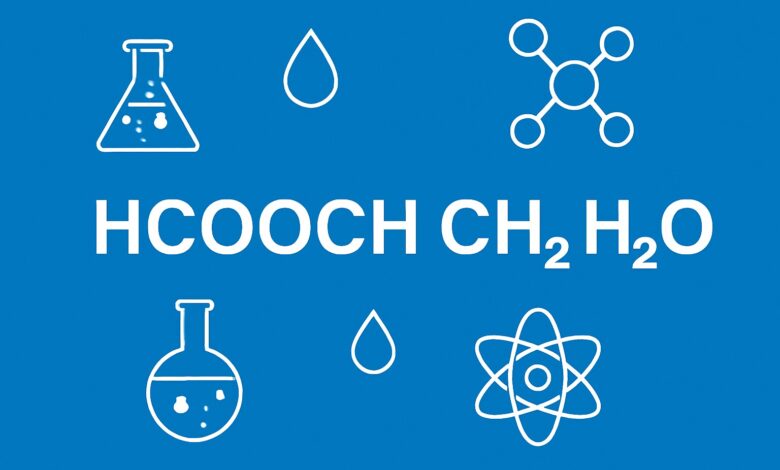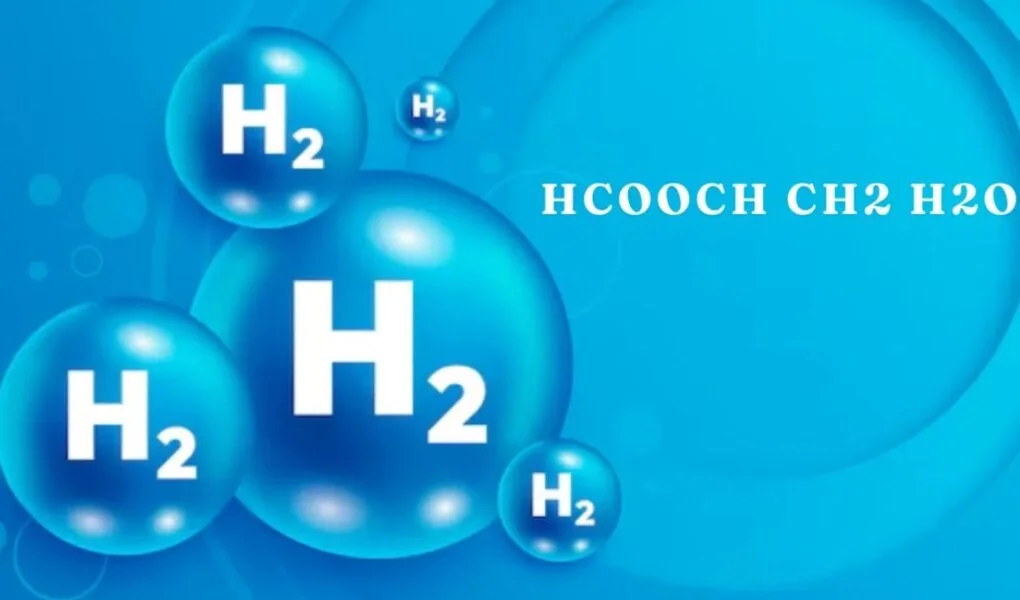Chemistry may seem like a complicated subject, but when we break it down to the basics of molecular formulas and reactions, it becomes a lot more fascinating. In this article, we’ll take a closer look at the molecular components HCOOH, CH₂, H₂O, which are common in organic and inorganic chemistry. Understanding their structure, behavior, and interaction gives us insight into many biological and industrial processes.
Whether you’re a student, a chemistry enthusiast, or someone curious about molecular science, this guide will help you navigate through the core concepts involving these compounds.
What is HCOOH?
The Structure and Properties of Formic Acid
HCOOH, also known as formic acid, is the simplest carboxylic acid. The molecular formula stands for one hydrogen (H), one carbon (C), and two oxygen (O) atoms along with another hydrogen, forming H–COOH. Structurally, the carbon atom is double-bonded to one oxygen and single-bonded to another oxygen which also bonds to a hydrogen atom, forming the carboxylic group.
Formic acid is a colorless, fuming liquid that has a pungent, penetrating odor. It is highly soluble in water due to its ability to form hydrogen bonds. Found naturally in ant venom (hence the name from the Latin word for ant, formica), this acid is a critical component in various chemical reactions and biological processes.
In terms of acidity, HCOOH is a weak acid but stronger than acetic acid. Its acidic property allows it to donate a proton (H⁺) in aqueous solutions, which plays a significant role in acid-base reactions.
Applications of HCOOH in Real Life
HCOOH is used in a variety of industries. In agriculture, it’s used as a preservative and antibacterial agent in livestock feed. In leather processing, formic acid is employed to regulate pH levels during tanning. The textile industry uses it for dyeing and finishing textiles.
Beyond industrial uses, it’s also found in laboratories for chemical synthesis. It plays an important role in reduction reactions, particularly in the transfer hydrogenation of alkenes and alkynes.
Role in Organic Chemistry
In organic chemistry, formic acid is known for being a simple but powerful functional group. It’s involved in several organic synthesis pathways, especially in forming formate esters and as a formylating agent. Due to its ability to act both as a reducing agent and an acid, HCOOH is quite versatile in reactions.
CH₂: The Methylene Group

Structural Overview of CH₂
CH₂, often referred to as the methylene group, is a part of many organic molecules. It consists of one carbon atom double-bonded to two hydrogen atoms. It usually appears in reactions as a reactive intermediate and is commonly seen in alkenes and organic chains like –CH₂–CH₂–.
The methylene group is highly reactive when it’s a carbene (CH₂ with two unpaired electrons). In its neutral form, it doesn’t exist freely for long but instead forms part of a bigger molecule. This makes CH₂ extremely important in polymer chemistry and organic synthesis.
CH₂ in Organic Reactions
CH₂ is a crucial building block in many hydrocarbons and organic molecules. In particular, it appears prominently in alkenes and alkanes, such as ethylene (C₂H₄) and propane (C₃H₈). It’s also a key part of polyethylene, one of the most widely used plastics in the world.
In organic reactions, CH₂ groups are often introduced or removed via elimination or substitution reactions. For example, in the Wittig reaction, a phosphorus ylide reacts with a carbonyl compound to form a double bond, often introducing a CH₂ group in the process.
Biological Relevance of CH₂
In biological systems, methylene bridges play a critical role in the structure of molecules. They form the backbone of long carbon chains in lipids and fatty acids. The flexibility and hydrophobicity of CH₂ groups make them ideal for membrane structures and storage molecules like triglycerides.
Moreover, many enzymes work by manipulating CH₂ groups through oxidation or reduction processes, thereby regulating metabolism and energy production in cells.
H₂O: The Universal Solvent
Chemical and Physical Properties of Water
H₂O, better known as water, is perhaps the most well-known molecule in the world. Comprising two hydrogen atoms and one oxygen atom, water is a polar molecule with a bent shape, resulting in its high surface tension and strong hydrogen bonding abilities.
Water has several unique properties: a high specific heat capacity, high heat of vaporization, and it expands upon freezing. These properties make it essential not only for life but also in environmental and industrial contexts.
The ability of water to dissolve a wide range of substances is due to its polarity. The slightly negative oxygen atom attracts positive ions, and the slightly positive hydrogen atoms attract negative ions, allowing it to dissolve salts, acids, bases, and polar organic compounds.
Water in Chemical Reactions
In chemistry, water often acts as a solvent, but it can also participate directly in reactions. For instance, in hydrolysis reactions, water breaks bonds within molecules. In acid-base chemistry, water can act both as a Bronsted-Lowry acid (donating H⁺) and base (accepting H⁺), making it amphoteric.
In redox reactions, water is sometimes a product or a reactant. For instance, in the combustion of hydrocarbons, water is produced alongside carbon dioxide. In electrolysis, water is split into hydrogen and oxygen gases, which is important in renewable energy production.
Water in Biological Systems
Water is vital for all known forms of life. It serves as the medium for biochemical reactions, helps transport nutrients and waste, and plays a role in temperature regulation. Cells are composed of around 70% water, and all metabolic processes depend on water’s unique chemical properties.
In DNA replication, protein synthesis, and cellular respiration, water molecules are essential participants. Even at the level of molecular signaling, water helps mediate reactions and stabilize proteins and enzymes through hydrogen bonding.
Interactions and Reactions Involving HCOOH, CH₂, and H₂O
HCOOH + H₂O: Acid Dissociation in Aqueous Solution
When formic acid (HCOOH) is dissolved in water, it partially dissociates to produce formate ions (HCOO⁻) and hydronium ions (H₃O⁺):
mathematicaCopyEditHCOOH + H₂O ⇌ HCOO⁻ + H₃O⁺
This reaction demonstrates the acid behavior of HCOOH and the amphoteric nature of water. The extent of this dissociation determines the pH of the solution and the reactivity in various environments.
CH₂ and Water: Limited Direct Interaction
CH₂ in its isolated form doesn’t typically react with water under normal conditions, as it’s highly reactive and short-lived. However, when part of a compound, CH₂-containing groups can undergo oxidation reactions where water might act as a solvent or participate indirectly.
For example, alkenes (like ethene, which contains a CH₂=CH₂ group) can react with water in the presence of an acid catalyst to form alcohols in a process known as hydration.
Real-World Implications
Understanding how HCOOH, CH₂, and H₂O interact is important in environmental chemistry. For example, in the breakdown of organic matter, formic acid can form and interact with water and hydrocarbons, influencing soil and water chemistry. In biochemical pathways, similar compounds help in energy generation and molecular synthesis.
Conclusion: Why It Matters
By diving deep into the roles of HCOOH, CH₂, and H₂O, we can see how fundamental these molecules are to both natural and industrial processes. From the acidic bite of formic acid to the molecular flexibility of methylene groups and the life-sustaining properties of water, each compound tells its own story in the vast language of chemistry.
Whether you’re synthesizing a polymer, studying biochemistry, or just curious about how the molecules around you behave, understanding these three players—HCOOH, CH₂, and H₂O—is a great starting point. Chemistry isn’t just about test tubes and formulas; it’s about the fundamental interactions that govern life and matter.



